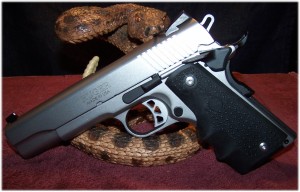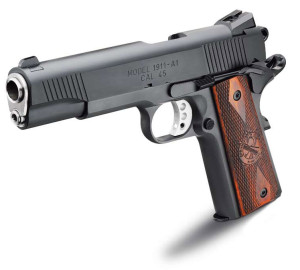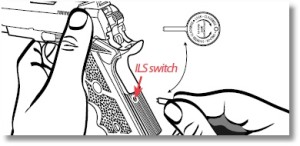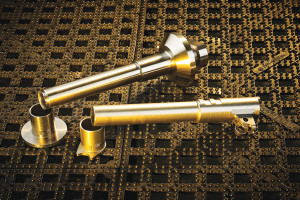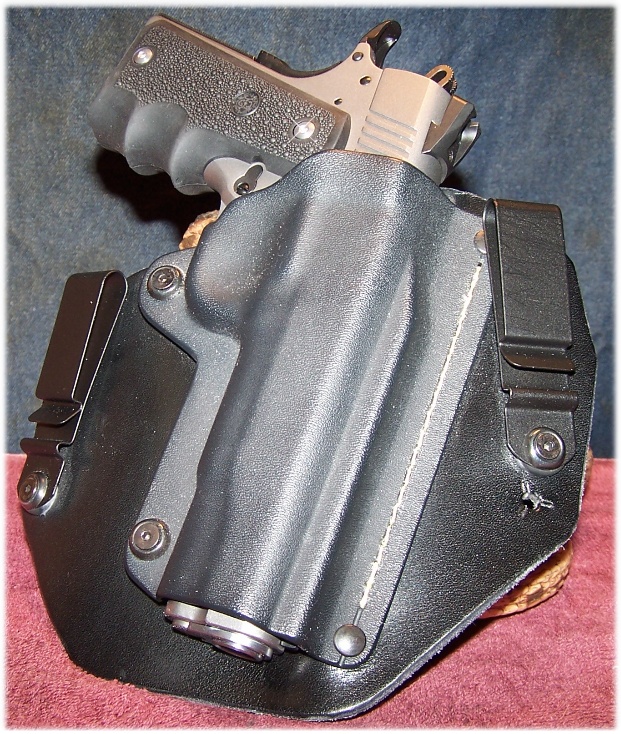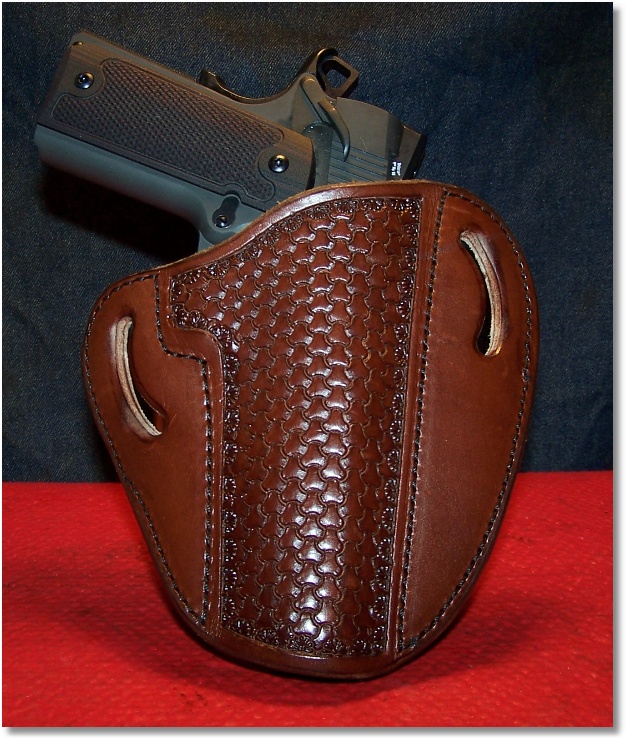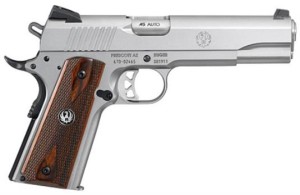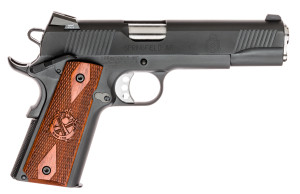One of the more popular things to do when deciding to buy a pistol is to compare what you want with similar pistols that are currently available. Both of the pistols in this review are considered “entry-level” pistols by some since they do not have the hand-crafted workmanship of “custom” pistols either by a custom builder or a manufacturer’s custom shop. Balderdash!
The two pistols in this review represent two fine pistols from two fine pistol manufacturers and are indicative as to what is available to us mere mortals who simply want a good 1911-based pistol for range duty or personal duty. There are, of course, less expensive and more expensive pistols available and I am amiable to carrying both at any time on any day. Carrying 1911-based pistols, of any size, is a personal choice as is carrying a Glock, Springfield, or Smith and Wesson polymer pistols. The two pistols in this comparison are what, I feel, provide a good foundation for anyone who is seeking a 1911-based pistol for the first time or for someone who is experienced with the 1911 platform and just wants another 1911-based pistol to add to an existing collection.
The Springfield 1911 Loaded is the older of the two with the Ruger SR1911 arriving later on the 1911 scene. Both have features that are the standard today and would have been considered “custom” in the not so distant past. I’ll attempt to address these features while not declaring them good or bad, as this is best left to the reader to decide. The beauty of the 1911-based pistols is that they can be easily configured to your likes, some of which the owner can do according to his or her capabilities, or submit the pistol to a qualified gunsmith for building your perfect pistol that, of course, only takes money and a will to spend it.
The two pistols in this comparison will serve the user just fine as they come out of the box.
STYLING:
Ruger SR1911:
Original 1911 Series “70” design provides for easy take-down and re-assembly. The SR1911 has the same slim traditional design as the M1911 and comes with hardwood grip panels and checkered metal mainspring housing. I found out that the original SR1911 was to have rubber grip panels but was later changed to the wood with Ruger logo. The grip panels are standard .25-inch thick panels and afford a good gripping surface.
Since I intend to carry the SR1911 at times, the grip panels were changed out for a Hogue Wraparound Rubber Grips with Finger Grooves 1911 Colt .45 9mm #C45-000 (see, RESOURCES) and mounted with Hogue Inc Colt Grip Hex head Screws Custom Stainless #45019 (see, RESOURCES) that add contrast to the stainless steel finish of the pistol. I prefer the Hogue rubber wraparound grips to many others when it comes to a handgun that I may have to fight with as my fingers fall right into the finger groves, they add to the girth of the grip area, and (I feel) that I have much more control of the pistol. Grip panel selection is, of course, up to the user and many may stay with the stock Ruger grip panels as they are adequate in providing a good gripping surface.
Springfield 1911 Loaded:
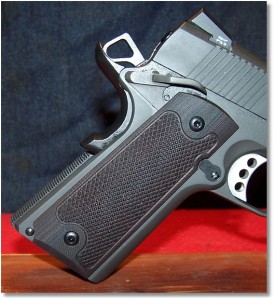
Springfield 1911 Loaded w/ LOK Grips Checkered Classic 1911 Grips Standard Full Size Commander grip panels – Right-Side
Like the Ruger SR1911, the Springfield 1911 Loaded follows the original design with obvious modern upgrades.
The Springfield 1911 Loaded comes with a forged carbon steel and Parkerized slide and frame. A stainless steel version is also available but was not at the time I purchased my Springfield 1911 Loaded.
The Springfield 1911 Loaded incorporates a main spring housing of plastic as compared to the metal housing on the Ruger SR1911. Unlike the Ruger SR1911, the mainspring housing incorporates a locking system that requires a special key to activate and deactivate. The key lock system essentially prevents the pistol from being cocked and the trigger from moving.
My particular version is non-railed (as JMB intended a 1911 to be) and incorporates the familiar Cross Cannon™ Double Diamond Cocobolo grip panels that exhibit a good surface for gripping. To personalize my pistol, I opted for a set of LOK 1911 Classics Red Black G10 grip panels that include a cutout for the Springfield ambidextrous thumb safety. The fit is perfect and the grips, while not rough in texture, provide an adequate amount of gripping surface. Grip panel selection is, of course, up to the user and many may stay with the stock Ruger grip panels as they are adequate in providing a good gripping surface. As my usual, I may swap out the grip panels again until I find just the right grip for the pistol.
MODERN MANUFACTURING:
Ruger SR1911:
Precision CNC-controlled machining process results in a superior slide-to-frame fit and smooth slide travel. The stainless steel barrel and bushing are produced from the same bar stock, on the same machine, for improved accuracy.
Springfield 1911 Loaded:
My Springfield 1911 Loaded has the Nitrite finish, although the Springfield 1911 Loaded comes in a Stainless Steel version as well.
PERFORMANCE:
Ruger SR1911:
Positive barrel lock-up allows for a superior accuracy out-of-the-box. Oversized ejection port and extended magazine release enhance competition performance.
Springfield 1911 Loaded:
Positive barrel lock-up allows for a superior accuracy out-of-the-box. Oversized ejection port and extended magazine release enhance competition performance.
TRIGGER AND HAMMER:
Both the Ruger SR1911 and Springfield 1911 Loaded utilize a lightweight, aluminum, skeletonized trigger features an adjustable over-travel stop and provides a very crisp, no creep, light trigger pull with a quick, positive reset. Skeletonized hammer is lightweight and provides faster cycling.
EXTRACTION AND EJECTION SYSTEM:
The Ruger SR1911 and the Springfield 1911 loaded utilize internal extractors and robust ejectors. Each does its job well.
As with the Slide Stop and Plunger Tube, the extractor base on the Springfield 1911 Loaded does not match the Parkerized finish on the rest of the pistol. I really have to admonish Springfield on not keeping the pistol finish uniform for all exposed parts. This malady does not appear on the Stainless Steel version of the pistol, as these parts are polished to accent the brushed finish of the pistol.
SIGHTING SYSTEM:
Ruger SR1911:
Dovetailed, 3-dot sight system features a Novak® LoMount Carry rear and standard front sight that combines optimal target acquisition in an ideal carry configuration. Some have complained that the sights are too small, but I have no issue with them.
The rear sight is drift-adjustable and is held into the slot with a hex-head screw. On my particular pistol, there was no need for windage adjustments as the sights were spot on.
Springfield 1911 Loaded:
The Springfield 1911 Loaded comes equipped with Low Profile Combat, 3 – Dot Tritium sights as standard fare and they are very effective for low-light targeting. The front sight in nicely dove-tailed into the slide as is the rear sight. The rear sight is drift adjustable for windage by loosening a hex-head tensioning screw. I found no reason to bother with it as sighting seemed to be spot on.
FRAME AND SLIDE:
Ruger SR1911:
Stainless steel frame and slide feature blasted, low-glare finish and slide rear serrations for positive grip. The slide-to-frame fit is tight as I have seen and felt on a production pistol.
The plunger tube is also an integral part of the frame and is unlike other 1911’s where the plunger tube is staked to the frame. Although I have never had a plunger tube fail, with the SR1911 that is one issue I don’t have to even concern myself with.
Springfield 1911 Loaded:
The Springfield 1911 Loaded utilizes a staked plunger tube as on the original M1911. Although I have never had a plunger tube fail, with the SR1911 that is one issue I don’t have to even concern myself with.
The slide of the Springfield 1911 Loaded utilizes angled slide serrations on the fore and aft end of the slide. “MODEL 1911-A1 CAL.45” is clearly roll-marked on the left side of the frame and “SPRINGFIELD ARMORY” with the Springfield cross-cannon logo marked on the right side.
The stainless steel barrel, barrel bushing, and recoil spring guide and bushing lend a nice contrast to the pistol. On my particular Springfield 1911 Loaded, the Slide Stop and plunger tube finish is different from the slide finish. Not that it is a big thing, but it would seem that Springfield could have better matched the finishes and made the plunger tube and slide lock Parkerized. It was like somebody just threw some parts in a bin with no regard as to how they were finished. The ambidextrous thumb safety is; however, Parkerized and matches the frame and slide.
SAFETIES:
Ruger SR1911:
Over-sized beaver-tail grip safety provides positive function and reliability. The beaver-tail grip safety is; however, not fitted quite well and does exhibits some side-to-side play, but I would rather have a loose fit than a too tight fit. The now standard “memory bump” is present and ensures that the hand fully presses the grip inward under varying hand positions.
The extended thumb safety and slide stop lever provide for improved, positive manipulation. Although the slide stop, thumb safety and magazine release button are extended, they are not obtrusive to the hand.
In keeping with the 1911 tradition, the thumb safety is mounted on the left side only.
The thumb safety is stiff when new. Some might consider it too stiff, but I would rather have my safety stiff than not. I do not ride the thumb safety when I shoot and would not appreciate it going “on safe” during a string of fire. As a side note, I do like ambidextrous safeties as I try to run a 1911 as much weak hand (left) as I can and an ambidextrous thumb safety is a great feature to have. With that said, I am not going to replace the thumb safety. I can also run a 1911 left-handed and know a few tricks about running the safety weak handed.
An internal safety feature is the use of a stiff firing pin spring and a lightweight titanium firing pin. This arrangement staved off the need for a firing pin block since the pistol can be dropped on the hammer and the firing pin will not reach the primer of a chambered round.
Springfield 1911 Loaded:
Over-sized beaver-tail grip safety provides positive function and reliability. The extended thumb safety and slide stop lever provide for improved, positive manipulation. Although the slide stop, thumb safety and magazine release button are extended, they are not obtrusive to the hand. The now standard “memory bump” is present and ensures that the hand fully presses the grip inward under varying hand positions. Unlike the Slide Stop and Plunger Tube, the grip safety blends well with the rest of the pistol. In my opinion, the grip safety is fitted better than the grip safety of the Ruger SR1911.
One feature that I like and many don’t is the ambidextrous thumb safety. It is extended but no obtrusive to the shooting hand – left or right. The thumb safety is stiff when new. Some might consider it too stiff, but I would rather have my safety stiff than not. There is a definite positive engagement when moving on or off safe.
An additional safety feature is the use of a key-lock device that is contained in the Main Spring Housing. Springfield calls this device an Internal Locking System (catchy, huh?). Using a special key (that you should not lose), you simply turn the locking device one way to totally lock up the action, or turn it in the opposite direction to make the pistol fully operational. I have read a few responses from Springfield 1911 owners that will remove this device or swap the Main Spring Housing out with one that does not incorporate the ILS. Personally, and if the Springfield 1911 Loaded ever is to become a handgun to be used for defensive purpose, the ILS will remain to stave off any accusations of making the pistol less safe.
MAGAZINES:
Ruger SR1911:
The Ruger SR1911 ships with two stainless steel magazines; one seven-round flush fit, and one 8-round magazine with a bumper pad. While the magazines are quality and they work well in the Ruger SR1911, I have found that they do not work well in some other 1911-based pistols. It seems that the slot in the magazines for the magazine catch is somewhat shorter than that in other magazines. This may cause the magazine to drop out of a non-Ruger pistol under fire. However, Wilson Combat and Meg-Gar magazines work well in the Ruger SR1911. My advice is to plan on purchasing quality magazines, although the provided magazines worked well in the Ruger SR1911.
Springfield 1911 Loaded:
The Springfield 1911 Loaded comes with two flush-fit, 7-round magazines. Again, Springfield fell down in the quality department when it came to providing magazines for this pistol. I took advantage of the free Springfield package and the magazines that came with the package (a two-pistol case, a double-magazine holder, and two magazines) were as bad as the ones that came with the pistol. You should plan on purchasing some good Wilson Combat, or other quality magazines, before taking this pistol to the range. You will avoid being disappointed by poor magazine performance with the provided magazines.
INTERNALS:
Ruger SR1911:
Internally, the SR1911 is well finished to include the feed ramp. Barrel lock-up is assured by more than adequate slots for the locking lugs of the barrel.
The barrel uses the classic JMB swing link design and is almost perfectly mated to the barrel bushing (nothing is perfect). I am not sure why Ruger chose to make the barrel bushing and barrel out of the same bar stock, but it seems to work just dandy. Perhaps, it has something to do with metal expansion rates or something, which is beyond my engineering knowledge. The barrel is throated to reliably feed hollow-point ammunition, and the feed ramp is polished.
The Ruger SR1911, with respect to the roots of the pistol, decided to incorporate a standard “G.I.” type operating system with the use of a short recoil spring guide and plug.
Although I would not consider it a safety, which is something that I consider as an item that prevents the pistol from going boom when you don’t want it to, a visual inspection port on top of the chamber allows for visual confirmation that chamber is loaded. This negates the need for performing a “press check” that I have never felt the need to do; if the slide is forward, I consider it loaded until I prove otherwise.
No, Martha! The Ruger SR1911 does not have a magazine disconnect safety.
Springfield 1911 Loaded:
Internally, the Springfield 1911 Loaded is well finished to include the feed ramp. Barrel lock-up is assured by more than adequate slots for the locking lugs of the barrel.
The barrel uses the classic JMB swing link design and is almost perfectly mated to the barrel bushing (nothing is perfect). The barrel is throated to reliably feed hollow-point ammunition, and the feed ramp is polished.
No, Martha! The Springfield 1911 Loaded does not have a magazine disconnect safety.
 The Springfield 1911 Loaded deviates from the original design by incorporating a two-piece, full length recoil spring guide. This adds about 1-ounce to the weight of the pistol. With this guide rod arrangement, the user must first unscrew the front section of the guide rod with a 5/32-inch Allen head tool. Then, the disassembly is the same as a “standard” 1911 pistol. I have read where a lot of users simply replace this system with a standard recoil spring setup. I have no qualms with it as long as it works as it should. Again, it is a matter of preference. If you are too lazy to perform the one additional step to disassemble and assemble the pistol, I really don’t know what to say.
The Springfield 1911 Loaded deviates from the original design by incorporating a two-piece, full length recoil spring guide. This adds about 1-ounce to the weight of the pistol. With this guide rod arrangement, the user must first unscrew the front section of the guide rod with a 5/32-inch Allen head tool. Then, the disassembly is the same as a “standard” 1911 pistol. I have read where a lot of users simply replace this system with a standard recoil spring setup. I have no qualms with it as long as it works as it should. Again, it is a matter of preference. If you are too lazy to perform the one additional step to disassemble and assemble the pistol, I really don’t know what to say.
Although I would not consider it a safety, which is something that I consider as an item that prevents the pistol from going boom when you don’t want it to, a visual inspection port on top of the chamber allows for visual confirmation that chamber is loaded. This negates the need for performing a “press check” that I have never felt the need to do; if the slide is forward, I consider it loaded until I prove otherwise.
VISUAL IMPACT:
Ruger SR1911:
The SR1911 is a very cleanly finished pistol. There are no front serrations or fancy sculpturing and the eight rear serrations are nicely blended into the pistol while providing a good purchase for the hand. All edges are nicely finished.
The front and rear sight, extended magazine release button, slide lock, hammer, thumb safety, beaver-tail grip safety, extractor button, and checkered metal mainspring housing and all pins are black and contrast nicely with the stainless steel frame and slide. With the addition of the Hogue wraparound rubber finger groove grips, there is a nice balance in the overall look of the pistol. Actually, the pistol looks more like the original SR1911 concept with the rubber grips, but with the additional finger grooves.
Ruger did a good job in laser-etching the slide and frame with RUGER MADE IN THE USA etched on the left side of the frame and the Ruger “Eagle” etched on the right side of the frame. Some might question the need for “READ INSTRUCTION MANUAL BEFORE USING FIREARM” on the underside of the frame, but at least Ruger did not put it on top of the slide.
The SR1911 uses the traditional straight barrel and bushing arrangement and utilizes a standard guide rod and guide rod bushing, which keeps the front end looking clean and mean. I have no intention of changing the guide rod system to a one-piece guide rod.
Although the metal mainspring housing is checkered, the front strap is clean of serrations. The Hogue Wraparound Rubber Grips with Finger Grooves covers this area and provides my shooting hand with a little more grip area to hold onto; I like a slightly over-size grip area.
The long, aluminum skeletonized trigger is nicely done and has a flat, serrated surface that I like. The edge of the trigger indexes right into the first joint of my shooting finger, which is where I prefer a trigger to be on full-sized handguns. The trigger also incorporates an over-travel stop screw, but blends well with the trigger. The trigger area is also relieved for the trigger finger of either hand.
From the right side, the lowered and flared ejection port provides a nice escape for expended shell casings and extracting and expending shell casings is something that the SR1911 does well as Ruger has beefed up the internal extractor for positive extraction.
The bead-blasted brushed finish of the pistol makes the SR1911 look classy without looking flashy.
Overall, the SR1911 is a clean looking, visually-appealing 1911-based pistol. It has features that would be considered custom in the past but are now considered standard fare. The quality is built in and there should be no doubt about that.
Springfield 1911 Loaded:
The Springfield 1911 Loaded (Parkerized version) is not a very cleanly finished pistol.
To me, the varying finishes on the pistol and some of its external parts take away the thought of quality. I feel that this pistol is a “Frankenstein” version of an otherwise fine pistol where the finishing parts seemingly come together with no thought as to the overall visual effect of the pistol. Also, the Parkerized finish on the Springfield 1911 Loaded displays every bump and scratch prominently it seems. I prefer the stainless steel version for overall ease of maintenance, durability, and resistance to corrosion in the hot and humid weather of the South. The current Parkerization of this pistol makes it look old and well used before its time.
At least Springfield did not see fit to have “READ INSTRUCTION MANUAL BEFORE USING FIREARM” on the underside of the frame as did Ruger.
The Springfield 1911 loaded uses the traditional straight barrel and bushing arrangement, but does not use a standard recoil spring guide arrangement. However, the blending of the recoil spring guide extension is well done and adds to the front-end look of the pistol. I do like it better than most full length guide rod bushings that make the pistol look unfinished.
Although the plastic mainspring housing is checkered, the front strap is clean of serrations. A Hogue Wraparound Rubber Grip with Finger Grooves would cover this area and provides the shooting hand with a little more grip area to hold onto. Of course, some grip tape could accomplish the same thing. I’m partial to the Hogue Wraparound Rubber Grip with Finger Grooves and a one may eventually find its way onto this pistol if I decide to keep it.
The long, aluminum skeletonized trigger is nicely done and has a flat, serrated surface that I like. The edge of the trigger indexes right into the first joint of my shooting finger, which is where I prefer a trigger to be on full-sized handguns. The trigger also incorporates an over-travel stop screw, but blends well with the trigger. The trigger area is also relieved for the trigger finger of either hand.
From the right side, the lowered and flared ejection port provides a nice escape for expended shell casings and extracting and expending shell casings is something that the SR1911 does well as Ruger has beefed up the internal extractor for positive extraction.
Overall, and in my opinion, the Springfield 1911 Loaded is a cluttered looking 1911-based pistol due to the front serrations. With the “peek through” feature that allows the user to see if a cartridge is chambered, I see no reason for the front serrations. But, some folks like them.
The Springfield 1911 Loaded has features that would be considered custom in the past but are now considered standard fare. However, I was disappointed with the overall quality of the pistol once I really had a chance to look at it in private. It is; however, very suitable as a range or carry pistol.
HOW THEY CARRY:
Regardless of how pretty or ugly a pistol might look; one of the important aspects is how a pistol carries on the body. If the SR1911 or Springfield 1911 Loaded is to be a range or bedside table gun, carrying it is of no importance. However, to those who wish to pack a full-size 1911-based pistol (like myself) how to best carry one is a prime consideration.
The SR1911 and Springfield 1911 Loaded are not light pistols with 2.7 pounds (unloaded) bearing down on your belt. Carrying the SR1911 needs a very good support system. Since I am used to packing “heavy” it is no bother to me, but it could be if you are not used to carrying something that could carry you to the bottom of a lake in no time (you need not worry; however, the SR1911 (or Springfield 1911 Loaded in Stainless form) is stainless and won’t rust before they pull you out of the water).
Whether you carry IWB or OWB, a good belt is an absolute necessity for concealment purposes. I prefer a pancake-style holster for OWB. If I am carrying openly, one of my requisites is that the holster has a thumb-break for security reasons. If I am carrying concealed under a garment(s), I prefer an open-top holster with nothing to interfere with the thumb safety.
For IWB carry, I like an IWB holster that will protect the entire forward end of the pistol. I also prefer an IWB holster without a sweat guard, which will provide my shooting hand full access to the grip and thumb safety when drawing the pistol from the holster.
I like the grip area to be pulled tightly into my side regardless if I am carrying IWB or OWB and, so far, a modified SHTF Gear ACE-1 Gen 2 Holster (http://www.shtfgear.com/)that has substantial Kydex to protect the 5-inch barreled SR1911 or Springfield 1911 Loaded has met my expectations for IWB carry. The holster is modified in that the sweat guard has been removed and I have added a little more forward cant to the holster to keep the butt of the pistol forward, which helps to blend the full-size grip of the SR1911 (or any pistol for that matter) into my side. For OWB carry, a fine holster from Leather Creek Holsters (http://www.leathercreekholsters.com/home.html) fits the bill (it was made locally by an expert) and I hope to have another of his fine holsters in the near future to fit my single-action Uberti revolvers). Of course, the holster choice for the 1911-based pistol is wide an varied and a personal choice, but it must be a good choice.
To accommodate the weight of the SR1911 or Springfield 1911 Loaded pistol and also two spare 8-round magazines of 230-grain hollow point ammunition, I also wear suspenders. This is, of course, a personal choice.
To carry the SR1911 or Springfield 1911 Loaded IWB, it also means wearing a t-shirt to prevent the butt of the pistol from rubbing against bare skin and from getting moisture during the hot summer months of the South from getting to the pistol (regardless of what I am carrying at the time). Some folks welcome the sweat shield on most IWB holsters, as it does what it means. However, and especially with a 1911-based pistol, I don’t want any possible interference with the operation of the thumb safety or my thumb getting to it during the draw stroke. I normally position the thumb on the shooting hand above the thumb safety during the actual draw stroke. When the gun is in the proper firing position, and I am ready to fire, the thumb safety is pushed off-safe. When I am holstering the pistol, the thumb of my shooting hand is below the thumb safety and applies pressure to it during holstering until the pistol is completely holstered. A sweat shield would interfere with this operation.
The SR1911 and Springfield 1911 Loaded is a hip gun; it needs to be riding on the hip (or just behind it) to get the full support you need to carry this beast. The SR1911 or Springfield 1911 Loaded is a heavy gun and if you are used to carrying one of those lightweight polymer wonders, the weight of the pistol will take getting used to – a lot of getting used to. But, carrying a full-sized 1911-based pistol can be carried effectively, and has been done, by better men than I.
RANGE TIME:
Ruger SR1911:
I am not going to write that the Ruger SR1911 is capable of placing 50-rounds in a sub-MOA group at 100 yards. Neither the pistol, nor am I, capable of that feat. The Ruger SR1911 is not, after all, a target pistol. Most custom 1911s will shoot groups half the size or smaller but cost three or four times as much as the Ruger. The Ruger SR1911 is a highly effective personal defense pistol, packs plenty of punch, and is one of the best 1911-based pistols that I have fired given the affordability aspect of the pistol.
The length of the barrel and the weight of the pistol equate to better accuracy, more punch to what ammunition you are shooting, and less recoil when shooting it over a lighter, shorter-barreled 1911-based pistol with or without a laser. I have proven that to myself and to other shooters.
The trigger, when new, was at first a little gritty but that has smoothed up after use and 4.5-pounds of trigger pull feels really good. A little take-up and a crisp break with no over-travel. No adjustment needs to be made to this pistol’s trigger for defensive use.
I have no problems taking out the red “X” area of a standard silhouette target at 15-yards with the SR1911 while shooting from a modified “weaver” stance. Beyond that distance I really need to brace the pistol to be that accurate, although I could put all shots on target probably and hold them in the 9-ring of a standard silhouette target. That is not a reflection of the SR1911, but more of a reflection of my capabilities as I get older.
One day at the range, and luckily on a day that I had the SR1911 with me, one of my shooting companions had brought a new shot timer with him. Now, I am not a fast pistol shooter by any means. I thought why not see how fast I could pull off my modified “Mozambique” drill with the SR1911. That is; 3 shots CM, 2 shots H, and 3 shots back to CM at 10 yards. From first shot to last, the best time I could do so was a hair under 3.5 seconds with all shots on target (starting from the “High Ready” position). Not “pro” times, but I am not a pro; just your average shooter with some experience. Yeah, I would carry the SR1911 as my PDA (Personal Defense Assistant). I kiddingly ask him to bring the timer back when I had one of my single-action revolvers and I would run the standard Mozambique drill with one of those.
The SR1911 now has about 350 rounds through it with nary a hitch. Not a lot of rounds in two years and not a torture test by any means, but enough to tell me that the SR1911 is a pistol that I could count on.
Springfield 1911 Loaded:
Range time consisted of a basic “where do I need to put the sights” and then performing a few two-handed and one-handed drills while trying to put 230-grain FMJ rounds from Georgia Ammo downrange and on target as best I could. I was not shooting for accuracy, but I was shooting for function. If I felt that I (and the Springfield 1911 Loaded) was accurate in doing so, it is a feather in the cap. I would do more accuracy testing at the next range outing.
I ran two magazines of 230-grain ball out the barrel for a function check and everything functioned well.
Next was to run the drill that I mentioned in one of my post at http://guntoters.com/index.php/topic,9384.0.html, but with a change-up in technique. Rather than pulling the pistol into me and swapping hands, the pistol was left extended toward the target and the transition went smoothly and without incident. The Springfield 1911 Loaded was run one handed and two handed. With the target at my usual 10-yards I went to work.
One hundred rounds were sent downrange without fail. The POI is a little high from POA but the necessary correction was made; with 230-grain ammunition the sights were set at the bottom of the center of the bulls-eye’s circle on a standard silhouette target. The majority of the bullet impacts was just above the center of the bulls-eye and produced a fist sized hole. All other bullet impacts, with noted exceptions, were in the 9-ring (one-handed, left-hand shooting caused some fliers, but that was expected for the first time running this drill with a pistol that I have never shot before.). After the drill was completed, I then emptied two magazines doing the Mozambique drill shooting strong side two-handed – two center mass one to the head. All resulting head shots were within a three-inch circle pretty close to center of the head. Body shots contributed to the fist-size hole just above the bulls-eye.
To put it as plainly as I can, the Springfield 1911 Loaded is a keeper and I have no doubt that I can rely on it. The ambidextrous safety, which was well used during the drill, has loosened to the point that only one thumb is necessary to operate it, and while the slide lock is still a little stiff, it is wearing in well. The trigger is superb and I knew exactly when the sear was going to release. Even as heavy as this pistol is, when firing one-handed there is still some significant muzzle flip; right-handed is up and left and left-handed is up and right. I have to work on that.
I had one of my shooting buddies run the pistol for a few rounds to get his reaction. After he ran a magazine worth of ammunition through the Springfield Loaded he turned to me and said, “Man, that gun just feels tight and solid!” I took that as he liked it. As a side note, he carries a Kimber as his EDC.
I left the range extremely pleased with the pistol.
SUMMARY:
Ruger SR1911:
With an MSRP of $939, and at today’s prices, the Ruger SR1911 cost a tad more than the Rock Island Armory Pro Match Ultra 5” 45ACP (MSRP $862), less the Springfield Armory 1911 Loaded (MSRP $962 for the Stainless Steel version), less than the Remington Arms 1911 R1 ENHANCED STAINLESS (MSRP $999), and somewhat north of the ROCK Ultra FS – 45 ACP (MSRP $722). However, my cash and carry price for one was $646.00 out the door with all tax, titles, and fees paid for. This; however, was in 2013 and today my price is a little bit higher if I chose to purchase another one ($699 cash and carry). If you shop around, you can find the Ruger SR1911 for a decent price.
I consider the Ruger SR1911 as an investment, as I do any firearm. The Ruger SR1911 is within reach of most of us mortals, and being mortal, one has to consider their choice of carry firearms (and other firearms) very carefully. There are very few firearms that I would consider having two and it usually comes down to cost and quality for the cost. I would purchase a second Ruger SR1911 for that reason.
If you are not concerned about cost, there are many fine 1911-based pistols out there and many gun shops that will be happy to take your money. If you are budget-conscience, like most of us are, then affordability is a prime concern when deciding to purchase a pistol for sport, HD, or SD and the Ruger delivers in that area along with Ruger quality in their products and after-purchase customer-service. I would not have the SR1911, the SR1911CMD, and the SR1911CMD-A if I thought otherwise, nor would I recommend them to you.
A lot of folks, experts in their own minds, classify the SR1911 as an “entry-level” pistol. While it is not a high priced Ed Brown, Wilson Combat, Night Hawk Custom, or even a custom Kimber, compared to what we had available to us in the not too distant past, the SR1911 is more like a full-featured near custom pistol.
And, you have to ask yourself, if John Moses Browning designed the 1911 with the features that it has today, what would we have left to improve upon? I can live with an “entry-level” pistol like the Ruger SR1911.
Springfield 1911 Loaded:
At this point I should say that the Springfield 1911 Loaded is one of the best, most accurate, and highly dependable and reliable 1911-based pistol I have ever shot. I don’t know about all that but it is a pretty darn good shooter, it spits bullets out the muzzle on command, and efficiently rids the pistol of expended shells so that I get to do it over again. Let’s just say that the Springfield 1911 Loaded is the combat version of the Range Officer, which is an exceptional firing handgun.
The Springfield 1911 Loaded has all the features that I was looking for an EDC 1911-based pistol. It is a full-fledged, full-size fighting handgun that can hold its own with more expensive 1911-based pistols. Managing recoil is easy due to the weight of the pistol. Muzzle flip is very little and you gain a little ballistic attitude and better accuracy with the 5” barrel.
Surprisingly, the Springfield 1911 Loaded (PX1909LP) is the same 43-ounce weight (unloaded) as the Stainless Steel version (Model PX9151LP). By comparison; the Remington R1 Enhanced weighs in at 39.5 ounces (unloaded), the Ruger SR1911 tugs at the pants with 39 ounces (unloaded), the Kimber Eclipse II (LG) tops the scales at 38 ounces (unloaded) while topping the scales at $1589 MSRP, and the Rock Ultra FS pops in at 39.84 ounces (unloaded). If you are looking for a compact and lightweight carry piece, the Springfield 1911 Loaded is not for you.
The PX1909LP comes with Low Profile Combat, 3 – Dot Tritium as standard fare; whereas, the (Model PX9151LP) has standard Low Profile Combat, 3 – Dot sights. I’ll take the night sights, thank you.
How well the Parkerized finish on the 1911 Loaded (PX1909LP) holds up is up for grabs; however, Glock uses a Parkerized finish over top of their Tennifer coating on the slides of their pistols. Parkerizing, of course, is commonly used on firearms as a more effective alternative to bluing and replaced bluing on military firearms since around WWII. I will have to say; however, that there is nothing prettier than a highly-polished and blued 1911.
The downsides to the pistols, from my vantage point, are the lack of ease when disassembling and reassembling and the two provided magazines should be placed in the “if everything else fails” box and replaced with quality magazines like Wilson Combat or comparable.
Along with this transaction, I also have taken advantage of the Springfield “Gear Up and Go” promotion offer and received 2 Extra Magazines that are as good as the money spent (if you spend zero expect zero in return), a Ballistic Nylon Dual Pistol Range Bag, and Double Mag Pouch. That, according to Springfield Armory, is $135 worth of goodies.
MSRP (according to Gallery of Guns) is $929 (and is out of stock). I can tell you that I paid a couple of Franklins less for it and even the counterman at the LGS was surprised at the price.
In 1974, the Springfield Armory name was licensed to Robert Reese, to form Springfield Armory, Inc., a company that manufactures semi-automatic versions of the M14 rifle and M1911 pistol. The company is not located in or near Springfield, Massachusetts and has no direct association with the original Springfield Armory. Aside from the weaponry foundation of the company, Springfield Armory, Inc. has produces many fine firearms for civilians and we are thankful for that.
Besides, when a full-size 1911-based pistol is pulled from the holster, and the large bore is revealed, people sit up and take notice.
THE CONCLUSION:
When it comes down to value vs. price, I have to go with the Ruger SR1911. You get an American-made quality package for much less than the Springfield 1911 Loaded. You can spend the money saved on a set of night sights, a set of grips that suit you, and/or if you like an ambidextrous thumb safety there is one available. Your cost outlay would be very close to the difference in price to the Springfield 1911 Loaded.
To be fair to Springfield, I shot the stainless steel version of the 1911 Loaded (one of our range guns) that had no telling how many rounds through it without cleaning, and I had to tighten the grip panel screws that were almost coming out of the pistol, but it shot just fine.
I am not biased toward the Ruger SR1911. If I felt that it was inferior to the Springfield 1911 Loaded, I would state my impressions based on what I see, what I hold, and what I shoot with my hands. I have no doubt that both pistols will serve you and me well and that is what makes your decision to purchase one or the other all the harder. I will reveal one point, however. If I were asked today which pistol, the Ruger SR1911 or the Springfield 1911 Loaded, I would buy again – the Ruger SR1911 would be my choice. Your may differ, but you have to run the guns first. If you have a range that has either of these pistols for rent, you really need to shoot them both and then make your decision.
RESOURCES:
- http://www.ruger.com/products/sr1911/specSheets/6700.html
- Hogue Wraparound Rubber Grips with Finger Grooves 1911 Colt .45 9mm #C45-000: http://www.amazon.com/Hogue-Wraparound-Rubber-Grooves-C45-000/dp/B00VQJFICY/ref=sr_1_1?ie=UTF8&qid=1451408878&sr=8-
- My review of the Hogue Wraparound Rubber Grips with Finger Grooves 1911 Colt .45 9mm #C45-000: https://guntoters.com/blog/2016/01/08/hogue-wraparound-rubber-grips-with-finger-grooves-1911-colt-45-9mm-c45-000/
- Springfield Armory 1911 Loaded Models: http://www.springfield-armory.com/products/1911-loaded-45-acp/
- My Review of the Ruger SR1911: https://guntoters.com/blog/2016/01/08/ruger-sr1911-model-no-6700/
- My review of the Springfield 1911 Loaded: https://guntoters.com/blog/2015/11/22/springfield-1911-loaded-px1909lp-review/
- My review of LOK grip panels for the 1911: https://guntoters.com/blog/2015/11/25/lok-grips-for-the-1911-user-review/
![]()




